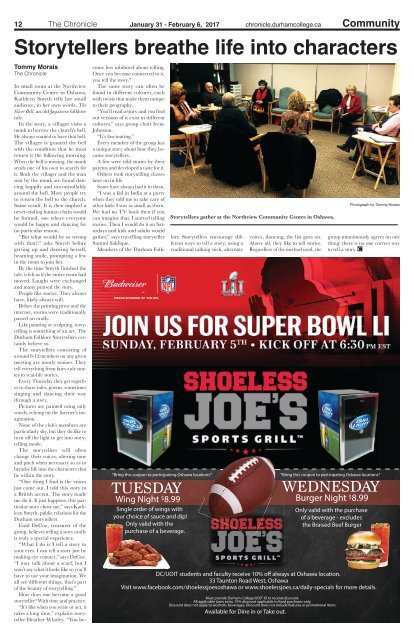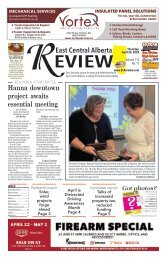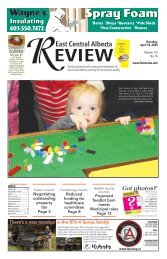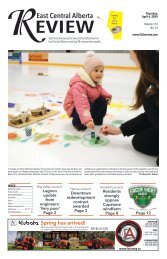You also want an ePaper? Increase the reach of your titles
YUMPU automatically turns print PDFs into web optimized ePapers that Google loves.
12 The Chronicle January 31 - February 6, 20<strong>17</strong> chronicle.durhamcollege.ca Community<br />
Storytellers breathe life into characters<br />
Tommy Morais<br />
The Chronicle<br />
Storytellers gather at the Northview Community Centre in Oshawa.<br />
In small room at the Northview<br />
Community Centre in Oshawa,<br />
Kathleen Smyth tells her small<br />
audience, in her own words, The<br />
Silver Bell, an old Japanese folklore<br />
tale.<br />
In the story, a villager visits a<br />
monk to borrow the church’s bell.<br />
He always wanted to have that bell.<br />
The villager is granted the bell<br />
with the condition that he must<br />
return it the following morning.<br />
When the bell is missing, the monk<br />
sends one of his own to search for<br />
it. Both the villager and the man<br />
sent by the monk are found dancing<br />
happily and uncontrollably<br />
around the bell. More people try<br />
to return the bell to the church.<br />
Same result. It is then implied a<br />
never-ending human chain would<br />
be formed, one where everyone<br />
would be happy and dancing for<br />
no particular reason.<br />
“But what would be so wrong<br />
with that?,” asks Smyth before<br />
getting up and dancing herself,<br />
beaming smile, prompting a few<br />
in the room to join her.<br />
By the time Smyth finished the<br />
tale, it felt as if the entire room had<br />
moved. Laughs were exchanged<br />
and many praised the story.<br />
People like stories. They always<br />
have, likely always will.<br />
Before the printing press and the<br />
internet, stories were traditionally<br />
passed on orally.<br />
Like painting or sculpting, storytelling<br />
is something of an art. The<br />
Durham Folklore Storytellers certainly<br />
believe so.<br />
The storytellers consisting of<br />
around 8-12 members on any given<br />
meeting are mostly seniors. They<br />
tell everything from fairy-tale stories<br />
to real-life stories.<br />
Every Thursday they get together<br />
to share tales, poems, sometimes<br />
singing and dancing their way<br />
through a story.<br />
Pictures are painted using only<br />
words, relying on the listener’s imagination.<br />
None of the club’s members are<br />
particularly shy, but they do like to<br />
turn off the light to get into storytelling<br />
mode.<br />
The storytellers will often<br />
change their voices, altering tone<br />
and pitch when necessary so as to<br />
breathe life into the characters that<br />
lie within the story.<br />
“One thing I find is the voices<br />
just come out. I told this story in<br />
a British accent. The story made<br />
me do it. It just happens, this particular<br />
story chose me,” says Kathleen<br />
Smyth, public relations for the<br />
Durham storytellers.<br />
Enid DeCoe, treasurer of the<br />
group, believes telling a story orally<br />
is truly a special experience.<br />
“What I do is I tell a story to<br />
your eyes. I can tell a story just by<br />
making eye contact,” says DeCoe.<br />
“I may talk about a scarf, but I<br />
won’t say what it looks like so you’ll<br />
have to use your imagination. We<br />
all see different things, that’s part<br />
of the beauty of storytelling.”<br />
How does one become a good<br />
storyteller? With time and practice.<br />
“It’s like when you write or act, it<br />
takes a long time,” explains storyteller<br />
Heather Whaley. “You become<br />
less inhibited about telling.<br />
Once you become connected to it,<br />
you tell the story.”<br />
The same story can often be<br />
found in different cultures, each<br />
with twists that make them unique<br />
to their geography.<br />
“You’ll read a story and you find<br />
out versions of it exist in different<br />
cultures,” says group chair Irene<br />
Johnston.<br />
“It’s fascinating.”<br />
Every member of the group has<br />
a unique story about how they became<br />
storytellers.<br />
A few were told stories by their<br />
parents and developed a taste for it.<br />
Others took storytelling classes<br />
later on in life.<br />
Some have always had it in them.<br />
“I was a kid in India at a party<br />
when they told me to take care of<br />
other kids. I was as small as them.<br />
We had no TV back then if you<br />
can imagine that. I started telling<br />
stories. Then I would do it on Saturdays<br />
and kids and adults would<br />
gather,” says travelling storyteller<br />
Summi Siddique.<br />
Members of the Durham Folklore<br />
Storytellers encourage different<br />
ways to tell a story; using a<br />
traditional talking stick, alternate<br />
voices, dancing, the list goes on.<br />
Above all, they like to tell stories.<br />
Regardless of the method used, the<br />
Photograph by Tommy Morais<br />
group unanimously agrees on one<br />
thing: there is no one correct way<br />
to tell a story.


















